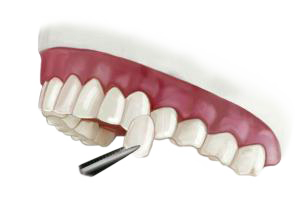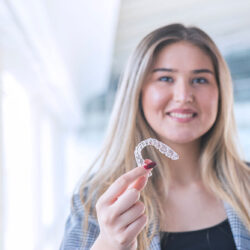Natural Looking Smile Enhancements with Porcelain Veneers
Quick Facts About Porcelain Veneers:
- Treatment Timeline: Can typically be completed in 2-3 office visits
- Ideal Candidates: Those with healthy teeth & gums with minor cosmetic imperfections
- Recovery: No downtime necessary
- Primary Benefits: Durable, long-lasting, natural-looking smile transformation
- Care & Maintenance: Regular brushing & flossing with twice-yearly professional cleanings
What Are Porcelain Veneers?
 Porcelain veneers are wafer-thin shells of porcelain that are custom-crafted to conceal a wide variety of cosmetic imperfections and improve the appearance of your teeth. Whether you are seeking to correct the look of one tooth, a series of teeth, or achieve a full smile makeover, veneers are considered to be one of the most versatile and conservative cosmetic dentistry options for smile enhancement.
Porcelain veneers are wafer-thin shells of porcelain that are custom-crafted to conceal a wide variety of cosmetic imperfections and improve the appearance of your teeth. Whether you are seeking to correct the look of one tooth, a series of teeth, or achieve a full smile makeover, veneers are considered to be one of the most versatile and conservative cosmetic dentistry options for smile enhancement.
If you are concerned about the condition, shape, color, or alignment of your teeth, porcelain veneers from Coronado Classic Dentistry may be the ideal treatment for achieving the beautiful, natural-looking smile you desire. To learn more about porcelain veneers we invite you to schedule a consultation and explore the informative sections provided below:
- Benefits of Porcelain Veneers
- Porcelain Veneers vs. Crowns
- Porcelain Veneers Process
- Porcelain Veneers Care
- Lifespan of Porcelain Veneers
- Porcelain Veneers Cost
- Porcelain Veneers FAQs
What Are the Benefits of Porcelain Veneers?
Porcelain veneers can be used to correct several common cosmetic concerns, including:
- Crooked or misaligned teeth
- Gaps between teeth
- Stained or discolored teeth
- Chipped, cracked, or misshapen teeth
- Short teeth
Giving your smile an improved appearance with porcelain veneers is often a relatively simple and effective process that yields impressive results. The size, shape, color, fit, and thickness of each veneer is precisely matched to the specifications of your tooth, providing for highly customized results that can look and feel incredibly natural. In addition, preparation for the ultra-thin veneers typically preserves much of the tooth body, which helps maintain dental strength and health. Dr. Jason Keckley is extensively experienced in the planning, design, preparation, and placement of porcelain veneers to create smile improvements that range from subtle to transformative.
Porcelain Veneers vs. Crowns
Although porcelain veneers and dental crowns can address both functional and aesthetic tooth imperfections, each type of restoration is used for a slightly different purpose. While thin porcelain veneers are primarily used to improve the superficial appearance of otherwise healthy teeth, porcelain crowns are more often used to strengthen teeth with badly damaged or decayed structure. When repairing teeth toward the back of the mouth or for patients who are prone to grinding or clenching, crowns are typically recommended, as they are more substantial and durable than dental veneers and cover the entire remaining portion of the tooth. Since porcelain veneers can achieve more natural-looking cosmetic improvements and require less tooth preparation than crowns, veneers are better suited for addressing aesthetic concerns related to the visible teeth at the front of the mouth.
How Does the Porcelain Veneers Process Work?
 Dr. Keckley will start your consultation with a thorough evaluation of your dental health and smile appearance. Together you will discuss areas you would like to improve and determine whether porcelain veneers treatment is the right choice for accomplishing your aesthetic goals. Once you have decided to move forward with porcelain veneers, Dr. Keckley will take digital images of your teeth and plan the specific fabrication details of your veneers. These plans will then be sent to a master ceramist who will craft your veneers to Dr. Keckley’s specifications. When the veneers are ready, Dr. Keckley will typically prepare the teeth by removing a very thin layer of the tooth enamel to accommodate the thickness of the veneer. The porcelain veneers are then bonded to the teeth with a strong, long-lasting cement. Once applied, porcelain veneers are often virtually indistinguishable from natural teeth, and with proper care, results can last for decades.
Dr. Keckley will start your consultation with a thorough evaluation of your dental health and smile appearance. Together you will discuss areas you would like to improve and determine whether porcelain veneers treatment is the right choice for accomplishing your aesthetic goals. Once you have decided to move forward with porcelain veneers, Dr. Keckley will take digital images of your teeth and plan the specific fabrication details of your veneers. These plans will then be sent to a master ceramist who will craft your veneers to Dr. Keckley’s specifications. When the veneers are ready, Dr. Keckley will typically prepare the teeth by removing a very thin layer of the tooth enamel to accommodate the thickness of the veneer. The porcelain veneers are then bonded to the teeth with a strong, long-lasting cement. Once applied, porcelain veneers are often virtually indistinguishable from natural teeth, and with proper care, results can last for decades.
What Is the Best Way to Care for My Porcelain Veneers?
Good daily oral hygiene—brushing and flossing twice a day—is considered the number one way to protect and care for your veneers. For patients who habitually grind or clench their teeth, Dr. Keckley may recommend a nightguard to wear while you sleep to protect your new smile. Since biting down on exceptionally hard foods may harm your veneers, your dentist may advise you to avoid certain food items. Finally, professional teeth cleanings and twice-yearly oral exams give Dr. Keckley an opportunity to promptly detect problems that could shorten the lifespan of your porcelain veneers.
How Long Do Porcelain Veneers Last?
The lifespan of porcelain veneers depends on a variety of factors that cannot be determined without a personal consultation. Since not all veneers and patients are alike, Dr. Keckley will assess your dental health and aesthetics during your consultation, and inform you about the potential lifespan of various veneers and materials.
How Much Do Porcelain Veneers Cost?
Each porcelain veneers procedure is customized by Dr. Keckley to address the patient’s unique dental needs and aesthetic goals. Those considering veneers should be aware that there is no set cost for porcelain veneers due to the variable nature of the procedure. The number and location of the veneers, along with the type of material the restorations are crafted from, will all be considered when determining the total price of the procedure. If you are comparing the cost of veneers among several cosmetic dentists, it is important to remember that the experience of the dentist, as well as the geographic location of the practice, may impact the quote you receive. At the conclusion of your consultation, Dr. Keckley can provide you with the total cost of your custom-tailored procedure. For patients interested in a payment plan with low interest rates, we offer in-house dental financing options.
Additional Frequently Asked Questions About Porcelain Veneers
Do porcelain veneers hurt?
Porcelain veneers are a minimally invasive, non-surgical approach to smile enhancement, and most patients report little to no pain or discomfort throughout the treatment process. A numbing agent will be used while your teeth are prepared, and Dr. Keckley’s conservative approach to dentistry ensures that only the thinnest layer of enamel is removed in order to accommodate the veneer. While veneers are generally a relatively painless cosmetic solution, some patients do report a temporary increase in tooth sensitivity, which typically fades within a week or two.
How old do you have to be to get veneers?
Porcelain dental veneers can be an ideal cosmetic solution for a broad range of concerns, and there are no specific age restrictions when it comes to getting them. However, veneers are typically not recommended for patients under the age of eighteen, as adolescent teeth are oftentimes more prone to shifting. Tooth movement can compromise the aesthetic results of the veneers and even potentially cause pain in cases where a tooth with a bonded veneer moves. You should also have good overall oral health and be done with any planned orthodontic work prior to receiving veneers.
Can I get just one veneer or will I need a whole set of veneers?
You can absolutely get just one veneer, although the aesthetic efficacy of a single veneer will vary based on your unique needs and goals. During your consultation, Dr. Keckley will discuss both your budget and your desired cosmetic outcome with you before making recommendations for the number of veneers needed to achieve optimal results. In many cases, you can achieve transformative results with just one or a few veneers!
What determines the color of my veneers?
Generally speaking, the color, shade, and opacity of your veneers will be as closely matched to the surrounding teeth as possible. This allows the veneers to blend in with the rest of your smile for a more natural-looking result. However, in cases where all or most of the visible teeth are receiving veneers, you may have the option to select a tooth color and shade that may otherwise have been unobtainable. Additional factors to consider when deciding on the color of your veneers include your skin tone, face shape, and the shade of your sclera (the whites of your eyes). Dr. Keckley will work closely with you throughout your consultation process and make recommendations in order to ensure that the final look and feel of your veneers meets—or even exceeds—your expectations.
Are porcelain veneers reversible?
Since the placement of porcelain veneers does typically require the removal of a thin layer of tooth structure, they are often considered an irreversible procedure. That said, with proper care and maintenance, porcelain veneers can oftentimes last for decades, and if they do eventually need to be replaced, it can be a chance to rejuvenate your smile all over again! Furthermore, Dr. Keckley’s extensive experience and conservative approach to veneer prep and placement means that the overall integrity of your tooth structure can be maintained, boosting your long-term oral health.
How strong are porcelain veneers?
Porcelain veneers are composed of dental-grade porcelain, which has incredible strength that is comparable to natural tooth enamel and can be capable of lasting decades. As strong as it is durable, the porcelain material enables the thin veneer shells placed over the teeth to be very resistant to chips, cracks, and breakage. However, if patients are prone to clenching or grinding their teeth, a night guard may be recommended to protect the porcelain veneers from potential damage over time.
Can you whiten porcelain veneers?
The non-porous composition of porcelain veneers makes it so that they are typically not receptive to whitening or bleaching treatments. That said, the high-quality porcelain used to create the veneers is highly resistant to staining and discoloration, meaning that whitening should not be necessary. Furthermore, prior to placement, the porcelain veneers are color-matched to the patient’s existing teeth. During the consultation process, Dr. Keckley can discuss your cosmetic goals with you in order to determine the ideal shade for your veneers. In some cases, teeth whitening may be recommended prior to veneer treatment if a patient desires an overall whiter smile.
What can’t you eat with porcelain veneers?
One of the benefits of porcelain veneers is the general ability to continue chewing, eating, and drinking just as you would with natural teeth. With that said, in order to preserve the strength of porcelain veneers, it helps to be mindful of certain foods or habits that may cause excessive wear and tear. This may include hard, dense, or pitted foods such as cherries, olives, bone-in meat, and nuts, as well as biting or chewing on ice cubes.
Contact Coronado Classic Dentistry
If you are interested in porcelain veneers, please contact our practice today to schedule your consultation. Dr. Keckley will be happy to answer any questions you have and help you decide if veneers are the right cosmetic option for you.
Medical Resources for Porcelain Veneers:
*Cleveland Clinic: What Are Dental Veneers?


